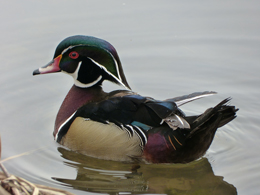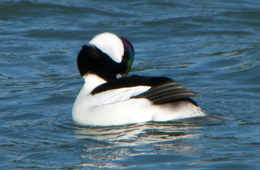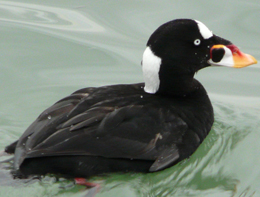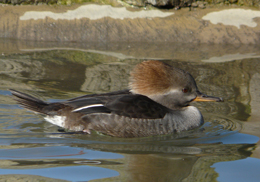As we head full on into the rainy season, remember that the rain brings with it several bonuses - including rejuvenating the City and making it look fresh and clean - and lots of ducks. In fact, during the Christmas bird count last year, birders counted almost 7,000 ducks in San Francisco, representing 21 different species. Only one-fifth of these ducks were Mallards - the species that most people associated with the word duck.

The Christmas bird count, by the way, was one of this country's first environmental efforts. Prior to 1900, many people participated in what was called the Christmas Side Hunt. Participants would choose sides and go out and shoot as many birds as possible - the side that shot the most birds won. Scientists and bird observers, concerned about rapidly declining bird populations, embraced an idea by ornithologist Frank Chapman, an officer in the then new Audubon Society, that instead of hunting birds, a Christmas bird census would be conducted.
On Christmas day, 1900, 27 participants counted 90 species of birds and 18,500 individual birds in 25 cities in the U.S. and Canada. The count has steadily grown since then. Last year, almost 60,000 participants in 2,124 locations on three continents (North America, South America, and Antarctica) counted more than 65 million birds! For a dense urban area, San Francisco does pretty well, with 172 species of birds found in the City last year.
 Getting back to ducks, two of the most beautiful ducks on the planet, Wood Ducks and Harlequin Ducks, are regularly seen in small numbers in San Francisco during the winter. Wood ducks nest in holes in trees (hence their name) and are usually quite secretive. Occasionally, however, they lose their shyness, when they hang out with other species of ducks. Last year, on the Christmas bird count, I was able to get quite close to a pair of wild Wood Ducks that had chosen to fly into the San Francisco Zoo and hang out with the zoo's captive duck collection. And this year, the week before Thanksgiving saw the arrival of a beautiful male Wood Duck, who swam with the Mallards on Stow Lake in Golden Gate Park, and would allow passerby's to approach quite closely without becoming alarmed. This duck is still in Golden Gate Park, and was last reported at Elk Glen Lake. Wood Ducks are also often seen at Lake Merced in the winter (but usually only in the very early morning).
Getting back to ducks, two of the most beautiful ducks on the planet, Wood Ducks and Harlequin Ducks, are regularly seen in small numbers in San Francisco during the winter. Wood ducks nest in holes in trees (hence their name) and are usually quite secretive. Occasionally, however, they lose their shyness, when they hang out with other species of ducks. Last year, on the Christmas bird count, I was able to get quite close to a pair of wild Wood Ducks that had chosen to fly into the San Francisco Zoo and hang out with the zoo's captive duck collection. And this year, the week before Thanksgiving saw the arrival of a beautiful male Wood Duck, who swam with the Mallards on Stow Lake in Golden Gate Park, and would allow passerby's to approach quite closely without becoming alarmed. This duck is still in Golden Gate Park, and was last reported at Elk Glen Lake. Wood Ducks are also often seen at Lake Merced in the winter (but usually only in the very early morning).

Harlequin Ducks are much rarer than Wood Ducks. Generally only one or two are found in San Francisco each winter, and almost always at Heron's Head Park, a delightful birding spot in the Bayview that attracts lots of ducks and shorebirds in the winter. The unusual variegated plumage of Harlequin Ducks reminded early observers of the pantomime costume of Arlecchino (Harlequin in French), a 16th Century Italian stage performer.

Harlequin Ducks are one of seven species of sea ducks that can be found in the ocean or bay waters around San Francisco in the winter. Almost as striking as the Harlequin Duck is the Surf Scoter, with a bill that always reminds me of the Tufted Puffin. I have had great close up encounters with Surf Scoters at Aquatic Park in January, and in some years large numbers of these ducks can be found just offshore from Lands End. Two other kinds of Scoters - Black and White-Winged are also found here in the winter - but are hard to see since they are quite a bit offshore west of Ocean Beach.


The most commonly seen sea duck is the Bufflehead (and once you see one, you'll know where the name came from). The male is a striking black and white from a distance, but close up the black can have a purple or green sheen to it. It's a mystery to me as to why this duck is considered a sea duck, since it nests at the top of trees inland in the summer. Although I haven't seen it, there are apparently very few things that match the spectacle of Bufflehead ducklings leaving the nest. The ducklings leave the nest 36 hours after they hatch, and jump to the ground - without feathers or the ability to fly - often from a height of 20 feet or more!
The Common Goldeneye is also found in San Francisco in small numbers every winter. The Crissy Field Lagoon can be a good place to get a close up look at one of these ducks - named for their bright yellow iris.
 Finally, one of my favorite ducks is the Hooded Merganser, which can almost always be found in Golden Gate Park in the winter, often at Lloyd's Lake, although they sometimes be found in the Arboretum or at the Chain of Lakes. The male has a fan shaped white head patch that it can increase in size when it raises its crest - it also appears to change the shape of the patch. The female has a reddish crest - it always looks like it is having a bad hair day, since the crest sticks out from the back of its head in multiple directions.
Finally, one of my favorite ducks is the Hooded Merganser, which can almost always be found in Golden Gate Park in the winter, often at Lloyd's Lake, although they sometimes be found in the Arboretum or at the Chain of Lakes. The male has a fan shaped white head patch that it can increase in size when it raises its crest - it also appears to change the shape of the patch. The female has a reddish crest - it always looks like it is having a bad hair day, since the crest sticks out from the back of its head in multiple directions.
© Photos by David Assmann